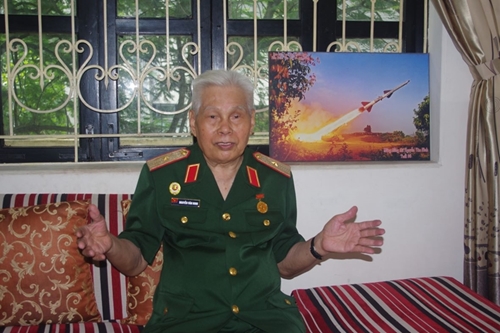On December 12, 1972, Major Nguyen Van Ninh, a missile soldier of the Operations Department, General Staff of the Vietnam People’s Army (VPA) (later Major General, Deputy Director of the Operations Department under the VPA’s General Staff), was in charge of the air defense operations division in the headquarters. Annually, he was tasked with gathering strategic information from intelligence and radar operation about the enemy’s moves to report and make recommendations to higher levels in terms of air defense operations.
Role of command and staff organs during the campaign
According to Major General Nguyen Van Ninh, the victory of the Hanoi - Hai Phong air defense campaign affirmed the sound leadership of the Party, the broad vision of President Ho Chi Minh, and the great achievements of the VPA’s General Staff. In order to prepare for the campaign, the General Staff requested that the Department of Military Intelligence and Reconnaissance to closely grasp the operations of B-52 aircraft. Accordingly, the department sent a team to Vinh Linh (Quang Tri province) to collect information by using ultra-shortwave radio receivers. The reconnaissance team studied and found a way to decode the enemy’s radio telegram related to the B-52's operations. Therefore, as the invaders launched a strategic raid in Hanoi, Hai Phong and some localities in the North in December 1972, the VPA’s General Staff was ready in any circumstance.
    |
 |
|
Major General Nguyen Van Ninh |
On June 28, 1972, General Vo Nguyen Giap, Commander-in-Chief of the VPA, noted that in the coming time, the U.S. Air Force would conducted fiercer raids, using B-52s, and directed the General Staff to organize a conference to map out combat plans to defeat these bombers.
Under the direction of General Vo Nguyen Giap, on July 6, 1972, two deputy chiefs of the VPA’s General Staff, Vuong Thua Vu and Phung The Tai co-chaired a conference to discuss how to destroy the B-52 stratofortresses. Deputy Chief of the VPA’s General Staff Phung The Tai concluded that the U.S. would bring B-52s to bomb Hanoi, Hai Phong, and neighboring localities as Vietnam was winning big in the South to put pressure on the country during the Paris Conference. Therefore, it was urgent to shoot down the B-52s. The ADAF was asked to finalize plans and conduct training for its troops while the VPA’s General Staff would track B-52 operations.
In late 1972, Deputy Chief of the VPA’s General Staff Phung The Tai asked comrade Nguyen Van Ninh to make preparations for two important meetings. The first was held on November 24, at the ADAF’s headquarters, where Chief of the VPA’s General Staff Van Tien Dung and Deputy Chief of the General Department of Political Affairs Le Quang Dao approved a combat plan against B-52 air raids in Hanoi and Hai Phong. On December 6, the Deputy Chief of the VPA’s General Staff chaired a meeting on the people’s air defense warfare and discussed measures when B-52s attacked the North.
“The VPA’s General Staff forecast situations to direct units to make preparations before the attack using the B-52 Stratofortress. As a result, on December 18, one B-52 Stratofortress was shot down in Hanoi,” affirmed Major General Nguyen Van Ninh.
Alerting Hanoi
In the morning of December 18, Nguyen Van Ninh was on-duty at the headquarters of the VPA’s General Staff. At 9:00 the same day, he received a mayday signal from the Department of Military Intelligence and Reconnaissance, informing him that about 13 U.S. aircraft were refueling in the east of the Philippines. His team reported to the higher level that an air raid was about to start.
In the afternoon, Deputy Chief of the VPA’s General Staff Phung The Tai returned from Gia Lam Airport, informed, “Comrade Le Duc Tho has just arrived in Hanoi. Negotiations failed,” and requested Nguyen Van Ninh to closely grasp the enemy’s moves.
At 16:30 on December 18, according to Phan Mac Lam, a soldier of the Department of Military Intelligence and Reconnaissance, many B-52s took off from Andersen military airfield on Guam, and were likely to bomb North Vietnam. Nguyen Van Ninh reported the information to the ADAF’s headquarters and Chief of the VPA’s General Staff Van Tien Dung.
He was then told to report to General Vo Nguyen Giap and to notify Hanoi and Hai Phong. Major Nguyen Van Ninh immediately pressed the button to pull the siren on the roof of Ba Dinh Hall, 15 other electric sirens in the city went off at the same time, people went to the basement; and the forces entered the battle position while guns were aimed at the sky.
At 19:40, the U.S. aircraft bombed the city as forecast. Thirty minutes later, a team on the top of Thang Long Flagpole reported that a B-52 was shot down in Soc Son district by Missile Battalion 59, Regiment 261, Hanoi Air Defense Division. However, Head of the VPA’s Department of Operations Vu Lang requested the team to verify the information.
    |
 |
|
Deputy Chief of the VPA’s General Staff Phung The Tai (left), ADAF Commander Le Van Tri (right) and Major Nguyen Van Ninh (behind) watch the symbol of a B-52, which was shot down on December 19, 1972. |
Under the chair of General Vo Nguyen Giap, the Standing Committee of the Central Military Commission held a meeting to map out plans in response to the situation. Accordingly, the ADAF force should closely coordinate with the people to defeat the enemy.
Early on December 19, a Mi-8 helicopter took Deputy Chief of the VPA’s General Staff Phung The Tai, ADAF Commander Le Van Tri, Nguyen Van Ninh, and Le Tu to Chuom field in Phu Lo commune, Kim Anh district, Vinh Phu province (currently Soc Son district, Hanoi), where a B-52 was shot down. Thousands of people were excited. Major Nguyen Van Ninh quickly found a picture of the B-52 bearing the words “Strategic Air Command” in the area.
Translated by Minh Anh